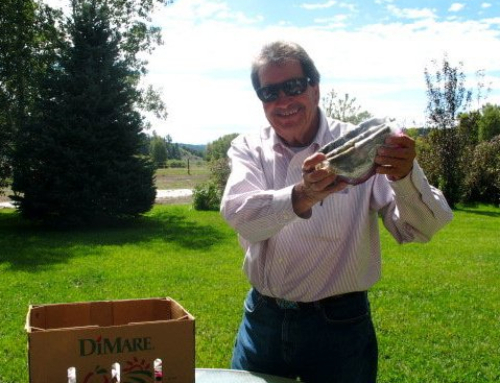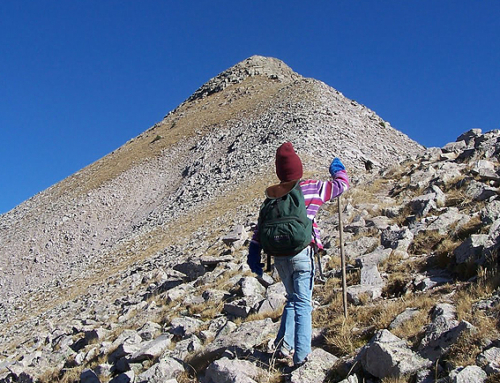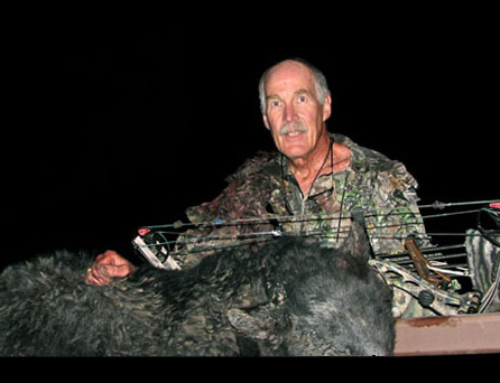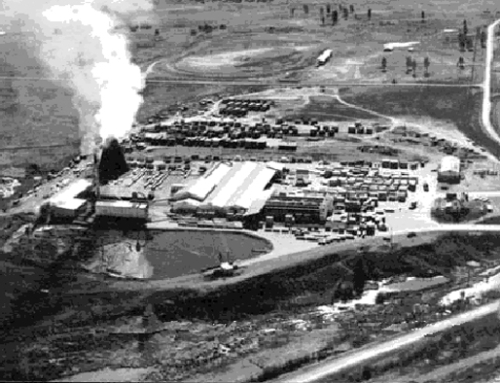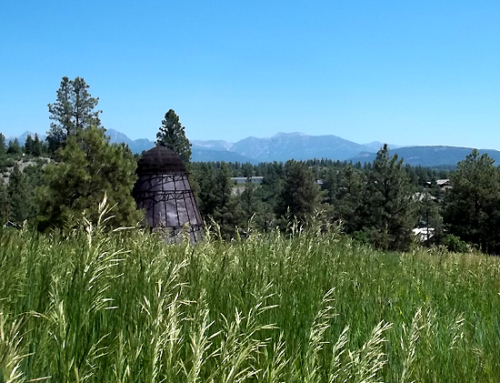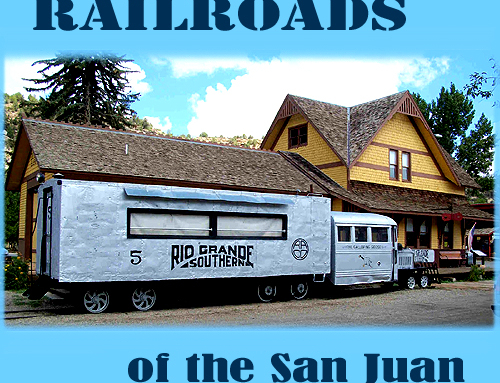
Editor’s note: Larry Masco is the great-grandson of Welch Nossaman.
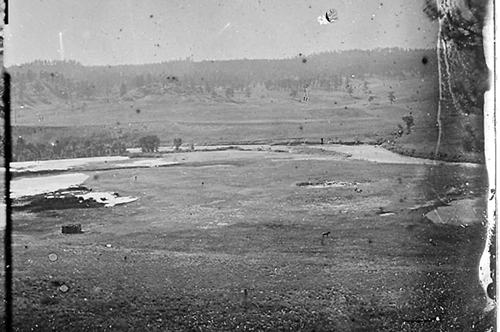
Sullivan climbed up the side of Reservoir Hill to get this photo looking west.
The San Juan Mountain area was very remote in the 1860s – 1900s. A major gold find produced the town of Summitville, east of Pagosa Springs and south of Wolf Creek Pass. Summitville was a vibrant mining community when Welch rode down Elwood Pass and the East Fork of the San Juan River to the hot spring. The spring was still Indian held.
He knew the Wild West when it was the Wild West. He was well acquainted with some famous characters of the west, such as Wyatt Earp. And he knew the hard work and hardships of settling in the west. He was Wellington Welch Nossaman, known commonly as Welch Nossaman.
His father’s name was Wellington. The Welch came from his mother’s side of the family. She was Sarah Elizabeth Welch. Sarah came from North Carolina, and Wellington from Virginia. They met in Iowa and were the parents of thirteen children. Welch was the fifth child and second son. Welch’s birth date was April 2nd, 1851. Being an April Fool was not one of Welch’s aspirations. His hopes paralleled those of many of his time, the urge to go west and settle in the wild country.
In February 1933, four years prior to his death, Welch related his life story at the insistence of some of his friends. He told it verbally to I. E. Carlin, who then wrote it. It sketches eight-plus years of his life, but highlights the period of his life from young manhood to mid life. The account is not chronological, but gives numerous dramatic and humorous insights into rugged western life from the mid 1870s to the 1920s. Welch remembered the Civil War, World War I and the Depression. He recollected that the Civil War “was a lot worse panic” than the depression, saying that, “it took 12 or 13 years before things started up again.”
Welch grew up in Pella, Iowa. Since they were a big family, the Nossamans worked at everything: “sawmilling, farming, coal mining, lime kilns, brick yards and doing labor with mules.” At age thirteen, Welch worked at the sawmill. It was there that he was friends with the three sons of Nick Earp, Jim, Virgil, and Wyatt. They often hunted squirrels and rabbits together, and he noted that they were handy with the six-shooters. At age eighteen, Welch even tried a little formal schooling. He felt uncomfortable with the younger kids in the basic A-B-C class, so he went into a class of his own. After three months of schooling, Welch was back out into the world of work.

This photo shows a large mound of mineral deposits in the distance. That may be the location of the pool in the other photos. Notice the complete lack of signs of human activity.
What really forced Welch to leave Pella was the inability to get ahead on his own. Every time he would build up a herd of cattle or teams of horses, his Dad would ask him to give them to his brothers-in-law. He even had to give them his saddle horse and saddle. Welch headed elsewhere and worked in sawmills and on trains for several years. In 1876 Welch made his way to Colorado in the company of Mark Butts, and they brought out a sawmill owned by a Dr. B.F. Keebles. They set up the mill near Summitville. In August 1876, Welch made his first visit to Pagosa, and in the early winter of that year, came in to Pagosa to check a claim that he had made. He had made acquaintance with two other gentlemen in Summitville who also had claims in Pagosa, and Dr. Keebles was trying to get a patent on Pagosa Springs as a mineral claim. The two acquaintances, Lafe Hamilton and Joe Baker, arrived in Pagosa several weeks later and built several cabins for that winter of 1876-77. In the spring, the Indians came and ran them off. That same routine occurred for several years, until Fort Lewis was established at the site. Nossaman spent several winters in Pagosa during the late 70s and would take off to Silverton, Summitville or elsewhere during the summer to earn money. But he felt Pagosa was his home and in 1882 homesteaded his ranch, which is located where the Decker and Formwalt ranches and homes are currently, just north of Pagosa Springs.
Nossaman later was one of the organizers of Citizens Bank. Pagosa was the setting for some of his favorite stories, which are shared in his life history. The most commonly circulated story is Welch’s encounter with I. Colorow Ignatio in the spring of 1877 and Ignatio’s demand, “me camp Pagosa, you vamoose”.
Many years ago in a small green valley, along the San Juan River, steam rose from a hot spring. This spring was called Pagosah, or “healing waters”, and was located on the southeastern rim of the San Juan basin, or Four Corners area, in Colorado. About a mile northward, Welch Nossaman sat in a cabin he and two other pioneers had built. As the first permanent American settlers in the area, they often confronted local Indians.
One day while he was at the cabin, and the other two pioneers were not there, a group of Indians came up to the cabin. Colorow Ignatio was the leader of the gang, and he came into the cabin asking Nossaman for coffee, tobacco and food. He replied to Colorow that he didn’t have any, and as he related from his life story, the result was that Colorow advanced. “He grabbed me by the arm and ran his finger across my throat and tried to scare me. When he done that, I kind of got scared. He had a big knife sticking in his belt that held his breechclout on. I thought he could pull it out in a shake, so I just jerked the six-shooter out, and put it up against his belly. When the muzzle of that gun got up against him, he just made two jumps and out he went … The Indians never came back, until about 8 o’clock the next morning, and then they came back and stopped right there in front of the cabin again and shot off three volleys in the air. Then this Colorow said, “Me camp Pagosa. You vamoose.” That means “leave”. We told him all right we would go, and we never went back until fall.”
Among his lesser-known stories are the following: On one occasion he and Joe Hankens, a tall Texan, were working on a road from the ranch to town. Nossaman tells, “The Indians came up there … one of them, a great tall Indian named Tappywatch had a pair of blue soldier pants. He wanted to know if I wouldn’t buy the pants. I said no, so Joe came up and said, ‘Welch, have you got $2 with you?’ I said yes, and he said ‘buy them.’ I said ‘you better try them on, Joe, maybe they won’t fit.’ So I gave the Indian $2 and he gave Joe the pants. Joe laid them away and on Sunday he took them out and thought he would put on his new pants and dress up a little. He got them out, and the seat was all cut out of them.”
“Right across from our cabin and about a quarter of a mile above was an old Indian campground where the Pagosa City Park is now. Under the cottonwoods is where they brought in their deer and franked (prepared) them for tanning, the deer hair was six or eight or ten or twelve inches deep. So we put the traps in there to catch foxes and coyotes and wolves. We saw a big track over there. We knew it wasn’t wolverine. So we set traps. Joe always got up at daylight to look at his traps, and in the morning he went up there to look at our traps. Lafe says ‘Welch, you better get up.’ I jumped up and put on my shoes and pants and struck out after Joe. I followed him right up there and he didn’t know it. I got behind a batch of willows and saw he had something in the trap. He went to get a big club, so I just keep still. He got the club he wanted and went back to the trap. It was a big wolf in the trap and it would back off as far as it could get– ten or twelve feet. Joe kept coming up to that wolf to hit it with the club. He didn’t have his six-shooter and I didn’t have any. The old wolf backed off as far as the chain would let him. Joe was crowding him, and the wolf gave a jump and hit him right in the breast and Joe fell over backward with his club and the wolf right on top of him. I got right out to see what I could do to help Joe out. The wolf left him and got off. He never said anything about it much.”
“John Rippy was a neighbor of ours at Pagosa. Rippy was always telling how quick he was. He was one of those slow fellows. It took him an hour to think, let alone act. One day he was grinding a sickle and there came a flash of lightning and a clap of thunder. It struck the end of that sickle he was holding and he dropped it, in time, after the lightning struck so that it didn’t get him. So he always used to say “the prairie dogs were as quick as Rippy’s lightning.” Later Rippy was shooting stumps and he went back to a shot that he didn’t think was going off, and it killed him. So that was the end of Rippy. Rippy was quick enough to dodge lightning, but he couldn’t dodge dynamite. That is proof that dynamite is quicker than lightning!
Welch Nossaman married Addie Phillips in 1885. The generations since have remained in Pagosa Springs. One of their three children, Tom Nossaman, spent most of his married life in the Pagosa Springs area on a ranch several miles north of Pagosa Springs, on Highway 160 at Fawn Gulch. Tom and his wife, Hazel, had two children, Sara and Martha. Sara and her husband John Masco have spent all their lives in Pagosa Springs and have two children, Larry and Russell. Russell currently resides in the community and maintains the family ranch on Snowball Road.
Welch Nossaman passed away in December 1937, leaving behind many stories of early life in Pagosa. His son Thomas Bowen Nossaman passed away in 1965 in Pagosa Springs. One of Tom Nossaman’s great-grandsons was named after him (Bowen Masco). Welch’s granddaughter, Martha Sharp, lives in Clifton, Colorado and another granddaughter, Sara Masco, lives in Pagosa Springs. Welch’s great-grandsons never knew him, but are grateful for the legacies he left with his life story and plan to pass on the stories to the next generation. He gives us a glimpse into life in the rugged west a century ago. And it should encourage us all to write our life story so that future generations can more fully appreciate our day and time.

